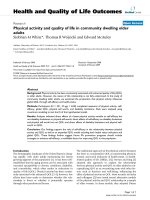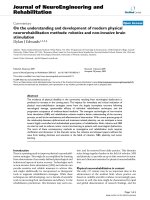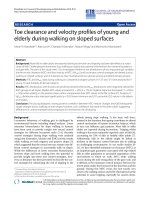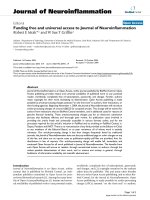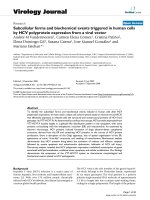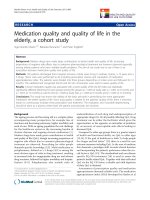Báo cáo hóa học: " On relaxed and contraction-proximal point algorithms in hilbert spaces" doc
Bạn đang xem bản rút gọn của tài liệu. Xem và tải ngay bản đầy đủ của tài liệu tại đây (252.42 KB, 8 trang )
RESEARC H Open Access
On relaxed and contraction-proximal point
algorithms in hilbert spaces
Shuyu Wang
*
and Fenghui Wang
* Correspondence: shyuwang@163.
com
Department Of Mathematics,
Luoyang Normal University,
Luoyang 471022, China
Abstract
We consider the relaxed and contraction-proximal point algorithms in Hilbert spaces.
Some conditions on the parameters for gu aranteeing the convergence of the
algorithm are relaxed or removed. As a result, we extend some recent results of
Ceng-Wu-Yao and Noor-Yao.
Keywords: maximal monotone operator, proximal point algorithm, firmly nonexpan-
sive operator
1. Introduction
Throughout, H denotes a real Hilbert s pace and A a multi-valued operator with
domain D(A). We know that A is called monotone if 〈u - v, x - y〉 ≥ 0, for any u Î Ax,
v Î Ay; maximal monotone if its graph G(A)={(x,y): x Î D(A), y Î Ax} is not prop-
erly contained in the graph of any other monotone operator. Denote by S:={x Î D
(A): 0 Î Ax}thezerosetandbyJ
c
:=(I + cA)
-1
the resolvent of A.Itiswellknown
that J
c
is single valued and D(J
c
)=H for any c >0.
A fundamental problem of monotone operators is that of finding an element x so
that 0 Î Ax. This problem is essential because it includes many concrete examples,
such as convex pr ogrammi ng and monotone variational inequaliti es. A successfu l and
powerful algorithm for solving this problem is the well-known proximal point algo-
rithm (PPA), which generates, for any initial guess, x
0
Î H, an iterative sequence as
x
n+1
= J
c
n
(x
n
+ e
n
)
,
(1:1)
where (c
n
) is a positive real sequence and (e
n
) is the error sequence (see [1]). To
guarantee the convergence of PPA, there are two kinds of accuracy criterion posed on
the error sequence:
(I)
e
n
≤ ε
n
,
∞
n
=
0
ε
n
< ∞ o
r
(II)
e
n
≤ η
n
˜
x
n
− x
n
,
∞
n
=
0
η
n
< ∞
,
where
˜
x
n
= J
c
n
(x
n
+ e
n
)
.
In 2001, Han and He [2] proved that in finite dimensional
Hilbert space criterion (II) can be replaced by
Wang and Wang Journal of Inequalities and Applications 2011, 2011:41
/>© 2011 Wang and Wang; licensee Springer. This is an Open Access article distributed under the terms of the Creative Commons
Attribution License (http://creativecomm ons.org/licenses/by/2.0), which permits unrestricted use, distribution, and reproductio n in
any medium, provided the original work is prop erly cited.
(II’)
e
n
≤ η
n
˜
x
n
− x
n
,
∞
n
=
0
η
2
n
< ∞
.
The infinite version was obtained by Marino and Xu [3].
There are various generations or modifications on the PPA. Among them Eckstein
and Bertsekas [4] proposed the relaxed proximal point algorithm (RPPA):
x
n+1
=(1− ρ
n
)x
n
+ ρ
n
J
c
n
(x
n
)+e
n
,
(1:2)
where (r
n
) ⊂ (0, 2) is a relaxation factor. The weak convergence of (1.2) is guaran-
teed provided that (e
n
) satisfies criterion (I),
c
n
≥
¯
c > 0, 0 <δ≤
ρ
n
≤ 2 − δ
.
(1:3)
On the other hand, since the PPA does not necessarily converge strongly (see [5]),
many authors have conducted worthwhile studies on modifying the PPA so that the
strong convergence is guaranteed (see, for instance, [6-8]). In particular, Marino and
Xu [3] proposed the contraction-proximal point algorithm (CPPA):
x
n+1
= λ
n
u +(1− λ
n
)J
c
n
(x
n
)+e
n
,
(1:4)
where the parameters above satisfy (i) lim
n
l
n
=0,Σ
n
l
n
= ∞; (ii) either Σ
n
|l
n
+1- l
n
|<∞;
or lim
n
l
n
/l
n
+1 = 1; (iii)
0 < c ≤ c
n
≤
¯
c < ∞,
n
|c
n+1
− c
n
| < ∞
;
(iv) Σ
n
||e
n
|| < ∞ .
Under these assumptions, the CPPA converges strongly to P
S
(u), the projection of u onto S.
In this article, we shall focus on the RPPA and CPPA. We note that the resolvent is
in fact the arithmetic mean of the identity and a nonexpansive operator. By using this
fact, we relax or remove some sufficient conditions to guarantee the convergence of
the algorithms. As a result, we extend and improve some recent results on the PPA.
2. Some lemmas
We know that an operator T : H ® H is called (i) nonexpansive if ||Tx - Ty|| ≤ || x -
y|| ∀x,y Î H; and (ii) firmly nonexpansive if 〈Tx - Ty, x - y〉 ≥ ||Tx - Ty||
2
∀x ,y Î H.
Denote by Fix(T)={x Î H : x = Tx}thefixedpointsetofT.Itiswellknownthat
firmly nonexpansive operators have the following properties.
Lemma 1 (Goebel-Kirk [9]). Let T be firmly nonexpansive. Then (1) 2T - I is nonexpan-
sive; (2) 〈Tx - x, Tx - z〉 ≤ 0 for all x Î H and for all z Î H Fix(T).
It is well known that J
c
is firmly nonexpansive and consequently nonexpansive;
moreover, S =Fix(J
c
). Since the fixed point set of nonexpansive operators is closed
convex, the projection P
s
onto the solution set S is well defined whenever S ≠ ∅. Here-
aft er, we assume that S is nonempty. The following lemmas play an important role in
our convergence analysis.
Lemma 2 (resolvent identity [3]). Let c, t >0. Then for any x Î H,
J
c
x = J
t
t
c
x +
1 −
t
c
J
c
x
.
Lemma 3 ([10]). Let (r
n
) be real sequence satisfying
0 < lim inf
n→∞
ρ
n
≤ lim sup
n
→∞
ρ
n
< 1
.
Wang and Wang Journal of Inequalities and Applications 2011, 2011:41
/>Page 2 of 8
Assume that (x
n
) and (y
n
) are bounded sequences in H satisfying x
n
+1 = (1 - r
n
)x
n
+
r
n
y
n
. If
lim sup
n
→
∞
(
y
n+1
− y
n
−
x
n+1
− x
n
) ≤ 0
,
then lim
n
®∞||x
n
-y
n
|| = 0.
Lemma 4 For r, s,>0,let T
r
=2J
r
- I. Then for any x Î H,
T
s
x − T
r
x
≤
1 −
s
r
x − T
r
x
.
(2:1)
Proof. Using the resolvent identity, we have
T
s
x − T
r
x
=2
J
s
x − J
s
s
r
x +
1 −
s
r
J
r
x
≤ 2
x −
s
r
x +
1 −
s
r
J
r
x
=2
1 −
s
r
x − J
r
x
=
1 −
s
r
x − T
r
x
,
where the inequality uses the nonexpansive property of the resolvent.
Lemma 5 ([11]). Let (ε
n
) and (s
n
) be positive real sequences. Assume that Σ
n
ε
n
< ∞.
If either (i) s
n+
1≤ (1+ε
n
)s
n
, or (ii) s
n+
1≤ ε
n
, then the limit of (s
n
) exists.
3. The relaxed proximal point algorithm
Under criterion (II’), Ceng et al. [12] considered another type, RPPA:
˜
x
n
= J
c
n
(x
n
+ e
n
),
x
n+1
=(1− ρ
n
)x
n
+ ρ
n
˜
x
n
,
(3:1)
and proved the weak convergence of (3.1) under the assumptions:
c
n
≥
¯
c > 0, 0 <δ≤
ρ
n
≤ 1
.
We note that the choice of (r
n
) excludes the case whenever r
n
Î (1,2), the overre-
laxation. The overrelaxation, however, may indeed speed up the convergence of the
algorithm (see [13]). Below, we shall improve their conditions on the relaxation factor
from 0 <δ ≤ r
n
≤ 1to0<δ ≤ r
n
≤ 2-δ.
Theorem 6 . Assume that the following conditions hold:
(a)
c
n
≥
¯
c > 0
;
(b) 0<δ ≤ r
n
≤ 2-δ;
(c)
n
e
n
≤ η
n
˜
x
n
− x
n
,
n
η
2
n
< ∞
.
Then the sequence generated by (3.1) converges weakly to a point in S.
Proof. The key point of our proof is to show lim
n
s
n
=0,where
s
n
=
x
n
− J
c
n
(x
n
)
.
To see this, let z Î S be fixed. Since
J
c
n
is firmly nonexpan sive and
z
∈ Fix(J
c
n
)
,
apply-
ing Lemma 1 yields
˜
x
n
− z,
˜
x
n
− x
n
− e
n
≤ 0
.
This together with (3.1) enables us to get
x
n+1
− z
2
−
x
n
− z
2
=
(x
n
− z)+ρ
n
(
˜
x
n
− x
n
)
2
−
x
n
− z
2
=2ρ
n
x
n
− z,
˜
x
n
− x
n
+ ρ
2
n
˜
x
n
− x
n
2
=2ρ
n
˜
x
n
− z,
˜
x
n
− x
n
−ρ
n
(2 − ρ
n
)
˜
x
n
− x
n
2
≤ 2ρ
n
˜
x
n
− z, e
n
−ρ
n
(2 − ρ
n
)
˜
x
n
− x
n
2
=2ρ
n
˜
x
n
− x
n
, e
n
+2ρ
n
x
n
− z, e
n
−ρ
n
(2 − ρ
n
)
˜
x
n
− x
n
2
≤ 2ρ
n
e
n
˜
x
n
− x
n
+2ρ
n
e
n
x
n
− z
− ρ
n
(2 − ρ
n
)
˜
x
n
− x
n
2
≤ 2ρ
n
η
n
˜
x
n
− x
n
2
+2ρ
n
η
n
˜
x
n
− x
n
x
n
− z
− ρ
n
(2 − ρ
n
)
˜
x
n
− x
n
2
.
Wang and Wang Journal of Inequalities and Applications 2011, 2011:41
/>Page 3 of 8
Using the basic inequality 2ab ≤ a
2
/ ε + εb
2
(a,b Î ℝ, ε > 0), we arrive at
2ρ
n
η
n
x
n
− z
˜
x
n
− x
n
≤
2ρ
n
2 − ρ
n
(
η
n
x
n
− z
)
2
+
2 − ρ
n
2ρ
n
ρ
n
˜
x
n
− x
n
2
=
2ρ
n
η
2
n
2 − ρ
n
x
n
− z
2
+
ρ
n
(2 − ρ
n
)
2
˜
x
n
− x
n
2
≤
2(2 − δ)η
2
n
δ
x
n
− z
2
+
ρ
n
(2 − ρ
n
)
2
˜
x
n
− x
n
2
= ε
n
x
n
− z
2
+
ρ
n
(2 − ρ
n
)
2
˜
x
n
− x
n
2
,
where
ε
n
=2(2− δ)η
2
n
/
δ
is a summable sequence. Substituting this into above yields
x
n+1
− z
2
≤ (1 + ε
n
)
x
n
− z
2
−
ρ
n
(2 − ρ
n
− 4η
n
)
2
˜
x
n
− x
n
2
.
Since by Lemma 5 the limit of ||x
n
- z ||
2
exists and lim inf
n
r
n
(2 - r
n
-4h
n
) ≥ δ (2 - δ),
this implies that
˜
x
n
− x
n
→ 0
.
On the other hand, we note that for all n Î N
s
n
≤ (1 + η
n
)
x
n
−
˜
x
n
→ 0
;
therefore, lim
n
s
n
= 0. The rest proof is similar to that of [12, Theorem 3.1].
We now turn to the RPPA (1.2). Under the criterion (I), the assumptions on relaxa-
tion factors can be relaxed to Σr
n
(2 - r
n
)=∞ (see [3, Theorem 3.3]). Since the proof
there is very technical, we wang to restate this result with a simple proof.
Theorem 7 . Assume that the following conditions hold:
(a) Σ
n
||e
n
|| < ∞;
(b) Σ
n
r
n
(2 - r
n
)=∞;
(c)
0 <
¯
c ≤ c
n
≤
˜
c < ∞
;
(d) Σ
n
|c
n
+1- c
n
|<∞.
Then the sequence generated by (1.2) converges weakly to a point in S.
Proof. The key step is to show lim
n
s
n
=0,where
s
n
=
x
n
− J
c
n
(x
n
)
.
It has been
shown that Σ
n
r
n
(2 - r
n
)s
n
< ∞ (see [3, Lemma 3.2]). Therefore, it remains to show
that lim
n
s
n
exists. By letting T
n
=2J
n
- I, we rewrite (2) as
x
n+1
=
1 −
ρ
n
2
x
n
+
ρ
n
2
T
n
x
n
+ e
n
.
In view of Lemma 4 and condition (c),
T
n+1
x
n+1
− T
n
x
n
≤
T
n+1
x
n+1
− T
n+1
x
n
+
T
n+1
x
n
− T
n
x
n
≤x
n
− x
n+1
+ T
n+1
x
n
− T
n
x
n
≤x
n
− x
n+1
+
1 −
c
n+1
c
n
T
n
x
n
− x
n
≤x
n
− x
n+1
+
|c
n+1
− c
n
|
¯
c
T
n
x
n
− x
n
≤
x
n
− x
n+1
+ M
|
c
n+1
− c
n
|
,
Wang and Wang Journal of Inequalities and Applications 2011, 2011:41
/>Page 4 of 8
where M > 0 is a suitable number. Consequently,
x
n+1
− T
n+1
x
n+1
=
1 −
ρ
n
2
x
n
+
ρ
n
2
T
n
x
n
+ e
n
− T
n+1
x
n+1
=
1 −
ρ
n
2
(x
n
− T
n
x
n
)+(T
n
x
n
− T
n+1
x
n+1
)+e
n
≤
1 −
ρ
n
2
x
n
− T
n
x
n
+
T
n
x
n
− T
n+1
x
n+1
+
e
n
≤
1 −
ρ
n
2
x
n
− T
n
x
n
+
x
n
− x
n+1
+ M|c
n+1
− c
n
| +
e
n
=
1 −
ρ
n
2
x
n
− T
n
x
n
+
ρ
n
2
(x
n
− T
n
x
n
)+e
n
+ M|c
n+1
− c
n
| +
e
n
≤
x
n
− T
n
x
n
+ M|c
n+1
− c
n
| +2
e
n
.
Using s
n
=||x
n
- T
n
x
n
||/2, we therefore arrive at
s
n
+1
≤ s
n
+ σ
n
,
where s
n
=2M |c
n
+1- c
n
|+4||e
n
|| satisfying Σ
n
s
n
< ∞ (due to (a) and (d)). By
Lemma 5, we finally conclude that lim
n
s
n
=0.
4. The contraction-proximal point algorithm
Recently, Yao and Noor [14] extended the CPPA to the following form:
x
n+1
= λ
n
u + r
n
x
n
+ δ
n
J
c
n
(x
n
)+e
n
,
(4:1)
where (l
n
),(r
n
),(δ
n
)⊆ (0,1) and l
n
+ r
n
+ δ
n
= 1. They proved the strong convergence
of the algorithm provided that (i)
c
n
≥
¯
c > 0, lim
n
|
c
n+1
− c
n
|
=0
;
(ii) 0 < lim inf
n
r
n
≤
lim sup
n
r
n
< 1; and (iii) Σ
n
||e
n
|| < ∞. Also, they claimed that their algorithm includes
the CPPA as a special case. This is, however, not the case, because condition (ii)
excludes the special case r
n
≡ 0. To overcome this drawback, we shall show the same
result by replacing condition (ii) with the weak condition:
lim sup
n
→∞
r
n
< 1 ⇔ lim inf
n→∞
δ
n
> 0
.
In this situation, the CPPA is evidently a speci al case of algorithm (4.1). The idea of
the following proof is followed by the second author [15].
Theorem 8. Let be (l
n
), (r
n
) and (δ
n
) be parameters in (4.1). Assume that the foll ow-
ing conditions hold:
(a) lim
n
l
n
=0,Σ
n
l
n
= ∞;
(b) lim sup
n
r
n
<1⇔ lim inf
n
δ
n
>0;
(c)
c
n
≥
¯
c > 0,
|
c
n+1
− c
n
|
→ 0
;
(d) Σ
n
||e
n
|| < ∞.
Then the sequence generated by (4.1) converges strongly to P
S
(u).
Proof. All we need to do is to prove ||x
n
+1- x
n
|| ® 0, since the rest proof is similar
to that of [14, Theorem 3.3]. To this end, set
J
n
= J
c
n
and T
n
=2J
n
- I.Itthenfollows
from (4.1) that
x
n+1
= λ
n
u + r
n
x
n
+
δ
n
2
(I + T
n
)x
n
+ e
n
=
r
n
+
δ
n
2
x
n
+ λ
n
u +
δ
n
2
T
n
x
n
+ e
n
.
Wang and Wang Journal of Inequalities and Applications 2011, 2011:41
/>Page 5 of 8
Let r
n
= l
n
+(δ
n
/2). Then the algorithm has the form:
x
n+1
=
(
1 − ρ
n
)
x
n
+ ρ
n
y
n
,
(4:2)
where y
n
=(2l
n
u + δ
n
T
n
x
n
+2e
n
)/2r
n.
Using nonex pansiveness of T
n
and Lemma 4,
we have
T
n+1
x
n+1
− T
n
x
n
≤
T
n+1
x
n+1
− T
n+1
x
n
+
T
n+1
x
n
− T
n
x
n
≤
x
n+1
− x
n
+
1 −
c
n+1
c
n
T
n
x
n
− x
n
≤
x
n+1
− x
n
+
|c
n
− c
n+1
|
¯
c
T
n
x
n
− x
n
.
(4:3)
On the other hand, it follows from the definition of y
n
that
y
n+1
− y
n
=
1
2ρ
n+1
(2λ
n+1
u + δ
n+1
T
n+1
x
n+1
+2e
n+1
)
−
1
2ρ
n
(2λ
n
u + δ
n
T
n
x
n
+2e
n
)
≤
λ
n+1
ρ
n+1
−
λ
n
ρ
n
u
+
e
n+1
ρ
n+1
+
e
n
ρ
n
+
δ
n+1
2ρ
n+1
T
n+1
x
n+1
−
δ
n
2ρ
n
T
n
x
n
≤
λ
n+1
ρ
n+1
−
λ
n
ρ
n
u
+
e
n+1
ρ
n+1
+
e
n
ρ
n
+
δ
n+1
2ρ
n+1
−
δ
n
2ρ
n
T
n+1
x
n+1
+
δ
n
2ρ
n
T
n+1
x
n+1
− T
n
x
n
.
(4:4)
Since (x
n
) is bounded and T
n
is nonexpansive, we can find M > 0 so that (||T
n
x
n
|| +
||x
n
|| + ||u||) ≤ M for all n Î N Adding (4.3) and (4.4) and noting δ
n
≤ 2r
n
yield
y
n+1
− y
n
≤
λ
n+1
ρ
n+1
−
λ
n
ρ
n
u
+
e
n+1
ρ
n+1
+
e
n
ρ
n
+
δ
n+1
2ρ
n+1
−
δ
n
2ρ
n
T
n+1
x
n+1
+
x
n+1
− x
n
+
|c
n
− c
n+1
|
¯
c
T
n
x
n
− x
n
≤
x
n+1
− x
n
+ M
λ
n+1
ρ
n+1
−
λ
n
ρ
n
+
e
n+1
ρ
n+1
+
e
n
ρ
n
+
δ
n+1
2ρ
n+1
−
δ
n
2ρ
n
+
|c
n
− c
n+1
|
¯
c
.
With the knowledge that ||e
n
||® 0 and
λ
n
ρ
n
=
2λ
n
2λ
n
+ δ
n
→ 0,
δ
n
2
ρ
n
=
δ
n
2λ
n
+ δ
n
→ 1
,
Wang and Wang Journal of Inequalities and Applications 2011, 2011:41
/>Page 6 of 8
we therefore deduce from (b) and (c) that
lim sup
n→∞
(
y
n+1
− y
n
−
x
n+1
− x
n
)
≤ lim sup
n→∞
M
λ
n+1
ρ
n+1
−
λ
n
ρ
n
+
e
n+1
ρ
n+1
+
e
n
ρ
n
+
δ
n+1
2ρ
n+1
−
δ
n
2ρ
n
+
|c
n
− c
n+1
|
¯
c
→ 0.
Note that lim inf
n
r
n
= lim inf
n
(δ
n
/2)> 0 and lim sup
n
r
n
= lim sup
n
(δ
n
/2) ≤ 1/2 < 1.
On the other hand, it is easy to check that (x
n
) is bounded and so is (y
n
) We therefore
apply Lemma 3 to yield lim
n
||x
n
- y
n
|| = 0. By means of (4.2), we finally have
x
n+1
− x
n
= ρ
n
x
n
− y
n
→
,
and thus the required result at once follows.
As a corollary, we improve [3, Theorem 4.1] as follows.
Theorem 9 . Assume that the following conditions hold:
(a) lim
n
l
n
=0,Σ
n
l
n
= ∞;
(b)
c
n
≥
¯
c > 0,
|
c
n+1
− c
n
|
→ 0
;
(c) Σ
n
||e
n
|| < ∞.
Then the sequence generated by (1.4) converges strongly to P
S
(u).
Abbreviations
CPPA: contraction-proximal point algorithm; PPA: proximal point algorithm; RPPA: relaxed proximal point algorithm.
Acknowledgements
The authors would like to express thier sincere thanks to the referees for their valuable suggestions. This study is
supported by the Natural Science Foundation of Department of Education, Henan(2011B110023).
Authors’ contributions
Both authors contributed equally to this work. All authors read and approved the final manuscript.
Competing interests
The authors declare that they have no competing interests.
Received: 13 March 2011 Accepted: 25 August 2011 Published: 25 August 2011
References
1. Rockafellar, RT: Monotone operators and the proximal point algorithm. SIAM J Control Optim. 14, 877–898 (1976).
doi:10.1137/0314056
2. Han, D, He, BS: A new accuracy criterion for approximate proximal point algorithms. J Math Anal Appl. 263, 343–354
(2001). doi:10.1006/jmaa.2001.7535
3. Marino, G, Xu, HK: Convergence of generalized proximal point algorithm. Comm Pure Appl Anal. 3, 791–808 (2004)
4. Eckstein, J, Bertsekas, DP: On the Douglas-Rachford splitting method and the proximal points algorithm for maximal
monotone operators. Math Programming. 55, 293–318 (1992). doi:10.1007/BF01581204
5. Güler, O: On the convergence of the proximal point algorithm for convex optimization. SIAM J Control Optim. 29,
403–419 (1991). doi:10.1137/0329022
6. Bauschke, HH, Combettes, PL: A weak-to-strong convergence principle for Fejér-monotone methods in Hilbert spaces.
Math Oper Res. 26, 248–264 (2001). doi:10.1287/moor.26.2.248.10558
7. Solodov, MV, Svaiter, BF: Forcing strong convergence of proximal point iterations in a Hilbert space. Math Programming
Ser. 87, 189–202 (2000)
8. Xu, HK: Iterative algorithms for nonlinear operators. J Lond Math Soc. 66, 240–256 (2002). doi:10.1112/
S0024610702003332
9. Goebel, K, Kirk, WA: Topics on Metric Fixed Point Theory. Cambridge University Press, Cambridge (1990)
10. Suzuki, T: A sufficient and necessary condition for Halpern-type strong convergence to fixed points of nonexpansive
mappings. Proc Am Math Soc. 135,99–106 (2007)
11. Tan, KK, Xu, HK: Approximating fixed points of nonexpansive mappings by the Ishikawa iteration process. J Math Anal
Appl. 178, 301–308 (1993). doi:10.1006/jmaa.1993.1309
12. Ceng, LC, Wu, SY, Yao, JC: New accuracy criteria for modified approximate proximal point algorithms in Hilbert space.
Taiwan J Math. 12, 1691–1705 (2008)
Wang and Wang Journal of Inequalities and Applications 2011, 2011:41
/>Page 7 of 8
13. Eckstein, J, Ferris, MC: Operator-splitting methods for monotone affine variational inequalities, with a parallel application
to optimal control. INFORMS J Comput. 10, 218–235 (1998). doi:10.1287/ijoc.10.2.218
14. Yao, Y, Noor, MA: On convergence criteria of generalized proximal point algorithms. J Comput Appl Math. 217,46–55
(2008). doi:10.1016/j.cam.2007.06.013
15. Wang, F: A note on the regularized proximal point algorithm. J Global Optim. 50, 531–535 (2011). doi:10.1007/s10898-
010-9611-z
doi:10.1186/1029-242X-2011-41
Cite this article as: Wang and Wang: On relaxed and contraction-proximal point algorithms in hilbert spaces.
Journal of Inequalities and Applications 2011 2011:41.
Submit your manuscript to a
journal and benefi t from:
7 Convenient online submission
7 Rigorous peer review
7 Immediate publication on acceptance
7 Open access: articles freely available online
7 High visibility within the fi eld
7 Retaining the copyright to your article
Submit your next manuscript at 7 springeropen.com
Wang and Wang Journal of Inequalities and Applications 2011, 2011:41
/>Page 8 of 8


